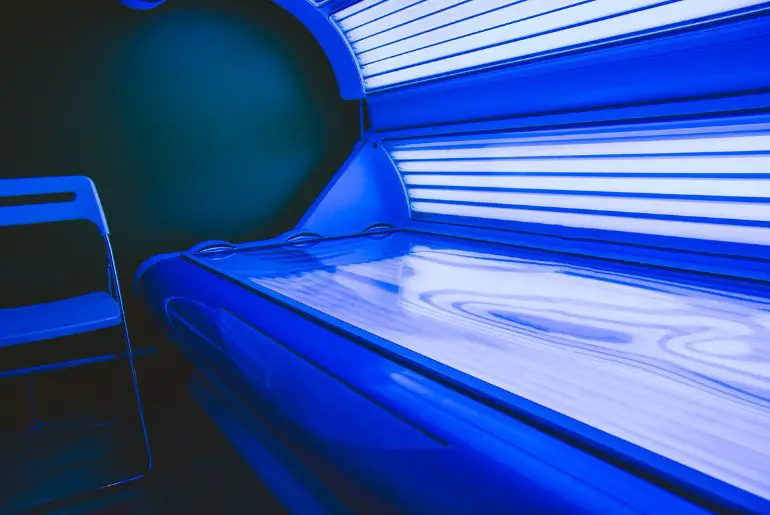Tanning is a great way to achieve a healthy and attractive glow, but it is important to consider how showering can affect your tan. While showering can be a great way to refresh and rejuvenate your skin after a day in the sun, it can also strip away your tan if not done properly. In this blog post, we will explore the effects of showering on a tan, when the best time is to shower after tanning, and how to shower to preserve your tan as much as possible properly.
We will also discuss the science behind how showering can affect a tan, including the effects of water temperature, pH levels, and the type of tan you have. Whether you have a sun tan, spray tan, or other self-tanner, understanding how to shower after tanning will help you to maintain your glow for longer.
You can shower after tanning, but it is important to do so properly to preserve your tan as much as possible. It is recommended to wait 2-3 hours after sun tanning and 8-12 hours after spray tanning before showering. When showering, use lukewarm water and gentle and pH-balanced products, avoid exfoliating scrubs or loofahs, and consider applying a moisturizer after showering. Additionally, following the instructions on self-tanning products is important if you use them.
The Effects of Showering After Tanning
Showering after tanning can have positive and negative effects on the color and longevity of your tan.
One of the positive effects of showering on a tan is that it can help to remove sweat and dirt from the skin, which can improve the overall appearance of the tan. A shower can also help to refresh and rejuvenate the skin after a day in the sun.
However, showering can also have negative effects on a tan. It can strip away the top layers of skin, which can cause a tan to fade more quickly. The water temperature, pH levels, and the products used during showering can all contribute to the fading of a tan.
Hot water, for example, can cause the skin to dry out, leading to flaking and peeling, which can cause the top layers of skin to come off and take the tan with it. In addition, the pH levels of tap water are typically on the alkaline side, which can affect the skin’s acidity. Soaps and scrubs with a high pH level can also affect the skin’s acidity, reducing melanin, the pigment that gives color to the skin.
The type of tan you have can also affect how showering will affect it. A sun tan, for example, can be more susceptible to fading due to showering than a spray tan, which has a protective barrier that can help to preserve the color. It’s important to be aware of the type of tan you have and to take the appropriate precautions when showering to ensure that your tan lasts as long as possible.
Exfoliating can also cause the top layers of skin to come off, which can cause the tan to fade more quickly.
When to Shower After Tanning
When it comes to showering after tanning, timing is key. The timing of showering after tanning can greatly impact how well your tan holds up. The timing for showering will also vary depending on the type of tan you have and the desired outcome.
For sun tans, it is generally recommended to wait at least 2-3 hours before showering. This allows the skin to absorb the UV rays and develop a deeper tan. After this time, showering can help remove sweat and dirt from the skin, improving the tan’s overall appearance.
For spray tans, it is recommended to wait at least 8-12 hours before showering. This allows the color to develop and set fully. Showering too soon can cause the color to fade or wash away.
If you are using self-tanning products, it is important to follow the instructions on the product, as the timing for showering may vary. It’s important to wait the recommended time before showering to give the self-tanner the time it needs to set and develop the color.
It’s also important to remember that the timing for showering may vary depending on the individual and the type of tanning done. Some people may find that they can shower earlier without affecting the color of their tan, while others may need to wait longer. It’s important to listen to your body and pay attention to how your tan is responding to showering to determine the best timing.
How to Properly Shower After Tanning
Properly showering after tanning can help preserve your tan’s color and longevity. Here are some tips on how to properly shower after tanning:
1. Use lukewarm water
Hot water can dry out the skin, which can cause flaking and peeling, leading to a loss of color. Instead, use lukewarm water, which is less harsh on the skin and can help preserve your tan’s color.
2. Use gentle, pH-balanced products
Harsh soaps and scrubs can strip away the top layers of skin, taking the tan with it. Instead, look for products specifically designed for use after tanning or for gentle and pH-balanced ones.
3. Avoid exfoliating scrubs or loofahs
It is important to avoid using exfoliating scrubs or loofahs when showering after tanning. These products can cause the top layers of skin to come off, taking the tan with it. Instead, use your hands to gently cleanse your skin, or opt for a soft washcloth.
4. Moisturize your skin
Consider applying a moisturizer after showering to keep your skin hydrated and healthy. Moisturizing your skin can help preserve the color of your tan and keep your skin looking and feeling smooth. Use a moisturizer formulated for after-tanning to keep your skin hydrated and healthy.
5. Be gentle
Avoid scrubbing or rubbing your skin too hard. This can cause the top layers of skin to come off, taking the tan with it. Be gentle when washing your skin, and use a light touch.
Can I Shower After Tanning With Bronzer?

Yes, you can shower after tanning with bronzer, but it is important to do so properly to avoid washing away the color.
Typically, bronzers are applied on top of the skin rather than absorbed into the skin like a self-tanner so they can be washed away more easily. It’s recommended to wait at least 2-3 hours before showering after applying bronzer to give the product time to set. When you shower, use lukewarm water and gentle and pH-balanced products, avoid exfoliating scrubs or loofahs and be gentle while washing your skin.
It’s also a good idea to avoid submerging yourself in water, such as swimming or taking a bath, as this can cause the bronzer to wash away more quickly. If you plan to swim or take a bath, it’s best to wait at least 24 hours after applying the bronzer before doing so.
It’s important to note that the effects of showering on bronzer may vary depending on the product you’re using, so it’s best to check the manufacturer’s recommendations or instructions before using it.
Some Common Ways to Tan
There are several common ways to achieve a tan:
1. Sun tanning

This is the most traditional and natural way to tan. It involves exposing the skin to the sun’s ultraviolet (UV) rays. Sun tanning can be done by lying out in the sun or using a sunbed or tanning booth.
2. Spray tanning

This is a popular alternative to sun tanning. It involves spraying a DHA (dihydroxyacetone) on the skin, which reacts with the amino acids in the skin to create a tan. Spray tans can be done in a salon or home using a self-tanning spray.
3. Self-tanning
This is another alternative to sun tanning. It involves applying a product, such as a lotion, cream, or mousse, to the skin that contains a self-tanning agent, such as DHA. This will cause a chemical reaction with the skin and create a tan. Self-tanners can be used at home.
4. Tanning beds
Tanning beds, also known as sunbeds or tanning booths, are another way to achieve a tan. They emit ultraviolet (UV) rays, similar to the sun, to darken the skin. Tanning beds can be found in tanning salons and are typically used for indoor tanning.

Using tanning beds can be an easy and convenient way to achieve a tan, but it also comes with some risks. The UV rays emitted by tanning beds are known to increase the risk of skin cancer and other skin damage. The World Health Organization (WHO) has classified UV-emitting tanning beds as a Group 1 carcinogen known to cause human cancer.
It’s also important to note that people with certain skin types are at a higher risk of sun damage and skin cancer when using tanning beds. People with fair skin, blonde or red hair, and light-colored eyes have a higher risk of sun damage and skin cancer when using tanning beds.
It’s also important to follow the guidelines and regulations of your country, state, or province regarding the use of tanning beds, as some places have banned tanning beds for people under 18 years old or have implemented other regulations to reduce the risks of using tanning beds.
5. Tanning pills
Some tanning pills in the market contain canthaxanthin, a naturally occurring pigment in some seafood and algae. These pills, when consumed, can cause a tan-like effect on the skin. However, the safety of these pills has yet to be fully established, and the FDA has warned about the potential health risks associated with using these pills.
It’s important to note that regardless of the method chosen, it’s crucial to protect your skin from harmful UV rays and follow instructions and guidelines of each method, as well as to keep an eye on the moles and any suspicious changes in the skin.
Conclusion
In conclusion, showering after tanning is important for maintaining a healthy and attractive glow. By understanding the effects of showering on a tan, the best timing for showering, and how to properly shower, you can help to preserve your tan for as long as possible.
As we’ve seen, showering can have positive and negative effects on a tan, depending on factors such as water temperature, pH levels, and the type of tan you have. Waiting 2-3 hours after sun tanning, 8-12 hours after spray tanning, and following the instructions on self-tanner products are crucial. Use gentle, pH-balanced products, avoid exfoliating scrubs or loofahs, and consider applying a moisturizer after showering.
By following these tips and recommendations, you can help to preserve the color of your tan and achieve the desired look. Remember to pay attention to how your tan responds to showering and adjust your routine accordingly. With the right approach, you can enjoy a beautiful, long-lasting tan.






